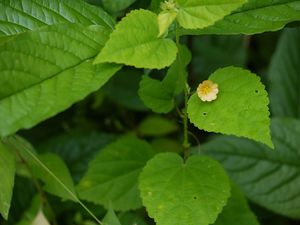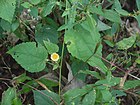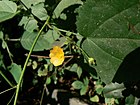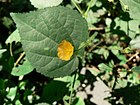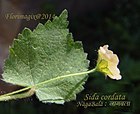Note: This is a project under development. The articles on this wiki are just being initiated and broadly incomplete. You can Help creating new pages.
Difference between revisions of "Sida cordata - Bhumibala"
(→Habit) |
|||
| (34 intermediate revisions by 2 users not shown) | |||
| Line 1: | Line 1: | ||
| − | |||
| − | |||
[[File:Sida cordata (6188338792).jpg|thumb|right|'' Bhumibala'', ''Sida cordata'']] | [[File:Sida cordata (6188338792).jpg|thumb|right|'' Bhumibala'', ''Sida cordata'']] | ||
| − | + | '''Bhumibala''' or '''Sida cordata''' is a perennial plant producing more or less herbaceous, procumbent stems up to 1 metre long from a woody rootstock.The plant is harvested from the wild for local medicinal use / Ayurvedic medicine and source of fibre. | |
| − | '''Bhumibala''' or '''Sida cordata''' is a perennial plant producing more or less herbaceous, procumbent stems up to 1 metre long from a woody rootstock.The plant is harvested from the wild for local medicinal use / Ayurvedic medicine and source of fibre | ||
==Uses== | ==Uses== | ||
| − | {{Uses| | + | {{Uses|Pimples}}, {{Uses|Indigestion}}, {{Uses|Boils}}, {{Uses|Wounds}}, {{Uses|Gonorrhoea}}, {{Uses|Venereal diseases}}, {{Uses|Cuts}}<ref name="Karnataka Medicinal Plants"/> |
==Parts Used== | ==Parts Used== | ||
| − | {{Parts Used| | + | {{Parts Used|Leaf}}, {{Parts Used|Root}}<ref name="Karnataka Medicinal Plants"/> |
==Chemical Composition== | ==Chemical Composition== | ||
| Line 15: | Line 12: | ||
==Common names== | ==Common names== | ||
| − | {{Common names|kn=Bekkinathale Gida, Bekkina thale gida|ml=Palkurunthotti, Vallikurunthotti, Nela-vaga|sa=Bhumibala, Nagabala|ta=Kurunthotti, Palampaci|te=Gayapuvaku, Benda, Tirunala|hi=Bhyunli, Bananiyar, Andiobal|en=Heart leaf}} | + | {{Common names|kn=Bekkinathale Gida, Bekkina thale gida|ml=Palkurunthotti, Vallikurunthotti, Nela-vaga|sa=Bhumibala, Nagabala|ta=Kurunthotti, Palampaci|te=Gayapuvaku, Benda, Tirunala|hi=Bhyunli, Bananiyar, Andiobal|en=Heart leaf}}<ref name="Common names"/> |
| + | |||
| + | ==Properties== | ||
| + | Reference: Dravya - Substance, Rasa - Taste, Guna - Qualities, Veerya - Potency, Vipaka - Post-digesion effect, Karma - Pharmacological activity, Prabhava - Therepeutics. | ||
| + | ===Dravya=== | ||
| + | |||
| + | ===Rasa=== | ||
| + | Tikta (Bitter), Madhura (Sweet) | ||
| + | ===Guna=== | ||
| + | Guru (Heavy), Snigdha (Unctuous) | ||
| + | ===Veerya=== | ||
| + | Shita (Cooling) | ||
| + | ===Vipaka=== | ||
| + | Madhura (Sweet) | ||
| + | ===Karma=== | ||
| + | |||
| + | ===Prabhava=== | ||
==Habit== | ==Habit== | ||
| − | {{Habit| | + | {{Habit|Perennial herb}} |
==Identification== | ==Identification== | ||
===Leaf=== | ===Leaf=== | ||
| − | {{Leaf| | + | {{Leaf|Cordate|Ovate|Leaves are acute or acuminate, serrate}}<ref name="Leaf"/> |
===Flower=== | ===Flower=== | ||
| − | {{Flower| | + | {{Flower|Bisexual|Axillary, solitary|Yellow|5|Pedicels to 2 cm long, filiform, articulated above the middle. Flowering from October to November}} |
===Fruit=== | ===Fruit=== | ||
| − | {{Fruit|| | + | {{Fruit|Schizocarp||2.5 mm long; mericarps 5, to 3 x 2 mm|Trigonous with rounded angles, apex shortly 2-beaked, completely enclosed in accrescent calyx|Seeds are 2 mm long, reniform, brownish-black|Fruiting season is October to November|}} |
===Other features=== | ===Other features=== | ||
==List of Ayurvedic medicine in which the herb is used== | ==List of Ayurvedic medicine in which the herb is used== | ||
| − | + | [[Manasaamritha Vatika]]<ref name="Karnataka Medicinal Plants"/> | |
==Where to get the saplings== | ==Where to get the saplings== | ||
| Line 40: | Line 53: | ||
==How to plant/cultivate== | ==How to plant/cultivate== | ||
| − | + | Seed can be sown in late autumn/spring/summer. Either sow directly into ground or in a pot. Lightly cover with soil and keep moist until they begin to germinate<ref name="How to plant/cultivate"/> | |
| − | |||
==Commonly seen growing in areas== | ==Commonly seen growing in areas== | ||
| − | {{Commonly seen| | + | {{Commonly seen|Grassy roadsides in china}}, {{Commonly seen|Uncultivated land}}, {{Commonly seen|Undergrowth in forest}}. |
==Photo Gallery== | ==Photo Gallery== | ||
<gallery class="left" caption="" widths="140px" heights="140px"> | <gallery class="left" caption="" widths="140px" heights="140px"> | ||
| − | + | Bekkina Tale Gida (Kannada- ಬೆಕ್ಕಿನ ತಲೆ ಗಿಡ) (3228959238).jpg | |
| − | + | ||
| + | |||
| + | Benda (in Telugu) (4122348702).jpg | ||
| + | |||
| + | |||
| + | Bhuibala (Marathi- भुईबला) (9953416454).jpg | ||
| − | + | ||
| + | Bhuinii (Hindi- भूइनी) (1990186664).jpg | ||
| + | |||
| + | |||
| + | Bhumibala (Sanskrit- भूमिबल) (1990207924).jpg | ||
| + | |||
| + | |||
| + | FM-Sida.cordata-Flr 01.jpg | ||
| + | |||
| + | |||
| + | FM-Sida.cordata-Flr 02.jpg | ||
| + | |||
| + | |||
| + | FM-Sida.cordata-Flr 03.jpg | ||
| + | |||
| + | |||
| + | FM-Sida.cordata-Flr 04.jpg | ||
| + | |||
| + | |||
| + | FM-Sida.cordata-Flr 05.JPG | ||
| + | |||
</gallery> | </gallery> | ||
==References== | ==References== | ||
| + | <references> | ||
| + | <ref name="chemical composition">[https://en.wikipedia.org/wiki/Sida_cordifolia Phytochemistry]</ref> | ||
| + | <ref name="Leaf">[https://indiabiodiversity.org/species/show/231135 Plant description]</ref> | ||
| + | <ref name="How to plant/cultivate">[http://herbalistics.com.au/product/sida-cordifolia-bala-seed/ Care and Cultivation]</ref> | ||
| + | <ref name="Common names">Karnataka Medicinal Plants Volume - 2 by Dr.M. R. Gurudeva, Page No. 475</ref> | ||
| − | + | <ref name="Karnataka Medicinal Plants">"Karnataka Medicinal Plants Volume - 2" by Dr.M. R. Gurudeva, Page No.478, Published by Divyachandra Prakashana, #45, Paapannana Tota, 1st Main road, Basaveshwara Nagara, Bengaluru. </ref> | |
| − | <ref name=" | ||
| − | |||
| − | |||
| − | |||
</references> | </references> | ||
==External Links== | ==External Links== | ||
| + | * [https://www.flowersofindia.net/catalog/slides/Long-Stalk%20Sida.html Sida cordata on flowers of india] | ||
| + | * [https://www.worldseedsupply.com/product/sida-cordifolia-bala-seeds/ Sida cordata on world seed supply] | ||
| + | * [https://www.researchgate.net/publication/282120237_Micro-Morphological_Study_of_'BALA'_Plant_Sida_cordifolia_L_Malvaceae_With_Special_Reference_to_Its_Propagation_Technique Micro-Morphological Study of 'BALA' Plant] | ||
[[Category:Herbs]] | [[Category:Herbs]] | ||
| + | [[Category:Malvaceae]] | ||
Latest revision as of 12:15, 21 June 2023
Bhumibala or Sida cordata is a perennial plant producing more or less herbaceous, procumbent stems up to 1 metre long from a woody rootstock.The plant is harvested from the wild for local medicinal use / Ayurvedic medicine and source of fibre.
Contents
- 1 Uses
- 2 Parts Used
- 3 Chemical Composition
- 4 Common names
- 5 Properties
- 6 Habit
- 7 Identification
- 8 List of Ayurvedic medicine in which the herb is used
- 9 Where to get the saplings
- 10 Mode of Propagation
- 11 How to plant/cultivate
- 12 Commonly seen growing in areas
- 13 Photo Gallery
- 14 References
- 15 External Links
Uses
Pimples, Indigestion, Boils, Wounds, Gonorrhoea, Venereal diseases, Cuts[1]
Parts Used
Chemical Composition
The following alkaloids were reported from S. cordifolia growing in India β-phenethylamine, ephedrine, pseudo-ephedrine, S-(+)-Nb-methyltryptophan methyl ester, hypaphorine, vasicinone, vasicinol, choline, and betaine[2]
Common names
| Language | Common name |
|---|---|
| Kannada | Bekkinathale Gida, Bekkina thale gida |
| Hindi | Bhyunli, Bananiyar, Andiobal |
| Malayalam | Palkurunthotti, Vallikurunthotti, Nela-vaga |
| Tamil | Kurunthotti, Palampaci |
| Telugu | Gayapuvaku, Benda, Tirunala |
| Marathi | NA |
| Gujarathi | NA |
| Punjabi | NA |
| Kashmiri | NA |
| Sanskrit | Bhumibala, Nagabala |
| English | Heart leaf |
Properties
Reference: Dravya - Substance, Rasa - Taste, Guna - Qualities, Veerya - Potency, Vipaka - Post-digesion effect, Karma - Pharmacological activity, Prabhava - Therepeutics.
Dravya
Rasa
Tikta (Bitter), Madhura (Sweet)
Guna
Guru (Heavy), Snigdha (Unctuous)
Veerya
Shita (Cooling)
Vipaka
Madhura (Sweet)
Karma
Prabhava
Habit
Identification
Leaf
| Kind | Shape | Feature |
|---|---|---|
| Cordate | Ovate | Leaves are acute or acuminate, serrate |
Flower
| Type | Size | Color and composition | Stamen | More information |
|---|---|---|---|---|
| Bisexual | Axillary, solitary | Yellow | 5 | Pedicels to 2 cm long, filiform, articulated above the middle. Flowering from October to November |
Fruit
| Type | Size | Mass | Appearance | Seeds | More information |
|---|---|---|---|---|---|
| Schizocarp | 2.5 mm long; mericarps 5, to 3 x 2 mm | Trigonous with rounded angles, apex shortly 2-beaked, completely enclosed in accrescent calyx | Seeds are 2 mm long, reniform, brownish-black | Fruiting season is October to November |
Other features
List of Ayurvedic medicine in which the herb is used
Where to get the saplings
Mode of Propagation
How to plant/cultivate
Seed can be sown in late autumn/spring/summer. Either sow directly into ground or in a pot. Lightly cover with soil and keep moist until they begin to germinate[5]
Commonly seen growing in areas
Grassy roadsides in china, Uncultivated land, Undergrowth in forest.
Photo Gallery
References
- ↑ 1.0 1.1 1.2 "Karnataka Medicinal Plants Volume - 2" by Dr.M. R. Gurudeva, Page No.478, Published by Divyachandra Prakashana, #45, Paapannana Tota, 1st Main road, Basaveshwara Nagara, Bengaluru.
- ↑ Phytochemistry
- ↑ Karnataka Medicinal Plants Volume - 2 by Dr.M. R. Gurudeva, Page No. 475
- ↑ Plant description
- ↑ Care and Cultivation
External Links
- Ayurvedic Herbs known to be helpful to treat Pimples
- Ayurvedic Herbs known to be helpful to treat Indigestion
- Ayurvedic Herbs known to be helpful to treat Boils
- Ayurvedic Herbs known to be helpful to treat Wounds
- Ayurvedic Herbs known to be helpful to treat Gonorrhoea
- Ayurvedic Herbs known to be helpful to treat Venereal diseases
- Ayurvedic Herbs known to be helpful to treat Cuts
- Herbs with Leaf used in medicine
- Herbs with Root used in medicine
- Herbs with common name in Kannada
- Herbs with common name in Hindi
- Herbs with common name in Malayalam
- Herbs with common name in Tamil
- Herbs with common name in Telugu
- Herbs with common name in Sanskrit
- Herbs with common name in English
- Habit - Perennial herb
- Index of Plants which can be propagated by Seeds
- Herbs that are commonly seen in the region of Grassy roadsides in china
- Herbs that are commonly seen in the region of Uncultivated land
- Herbs that are commonly seen in the region of Undergrowth in forest
- Herbs
- Malvaceae
